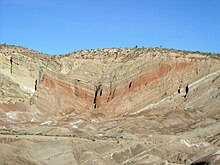Barstovian
Appearance


TheBarstovian North American Stageon thegeologic timescaleis the North Americanfaunal stageaccording to theNorth American Land Mammal Ageschronology (NALMA), typically set from 16,300,000 to 13,600,000 yearsBP,a period of2.7million years.[1]It is usually considered to overlap theLanghianandSerravallianstages of theMiddle Miocene.The Barstovian is preceded by theHemingfordianand followed by theClarendonianNALMA stages.
The Barstovian can be further divided into the substages of:
- late Late Barstovian: Lower boundary source of the base of the Langhian (approximate)
- early Late Barstovian: Base of the Langhian (approximate)
- early/lower Barstovian: Upper boundary source: base of Clarendonian (approximate)
Correlations[edit]
The Barstovian (15.97 to 13.6 Ma) correlates with:
- SALMA
- Colloncuran(15.5-13.8 Ma)[2]
- earliestLaventan(13.8-11.8 Ma)[3]
- ELMA-Astaracian(15.97-11.608 Ma)[4]
- Mammal Neogene Units,European Faunal Zones
- CPS[6]
- New Zealand stratigraphy-Southland epoch(15.9-10.92 Ma)[8]
- Clifdenian(15.9-13.65 Ma)[9]
- earliestLillburnian(13.65-12.7 Ma)[10]
- NMAC
- Shanwangian(16.9-13.65 Ma)[11]
- earliestTunggurian(13.65-11.1 Ma)[12]
References[edit]
- ^Paleobiology Database, Barstovian
- ^ColloncuranatFossilworks.org
- ^LaventanatFossilworks.org
- ^AstaracianatFossilworks.org
- ^MN 5 zoneatFossilworks.org
- ^Central Paratethys StagesatFossilworks.org
- ^BadenianatFossilworks.org
- ^Southland epochatFossilworks.org
- ^ClifdenianatFossilworks.org
- ^LillburnianatFossilworks.org
- ^ShanwangianatFossilworks.org
- ^TunggurianatFossilworks.org
